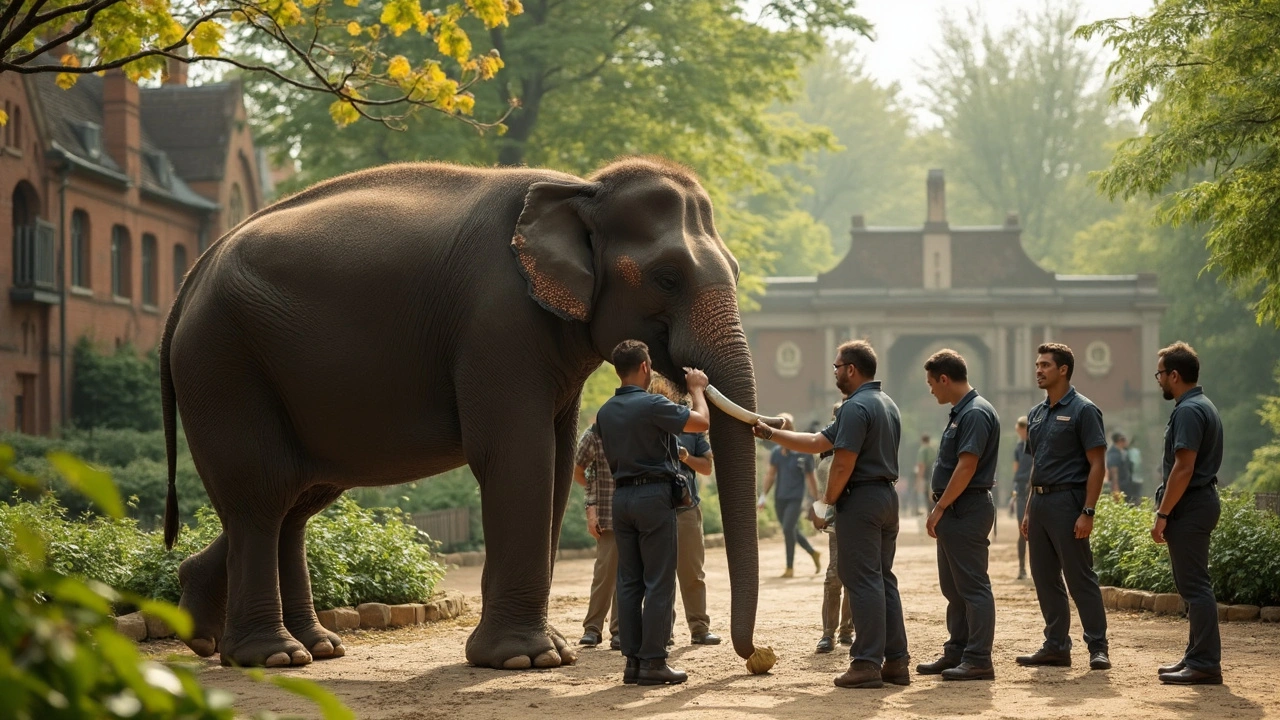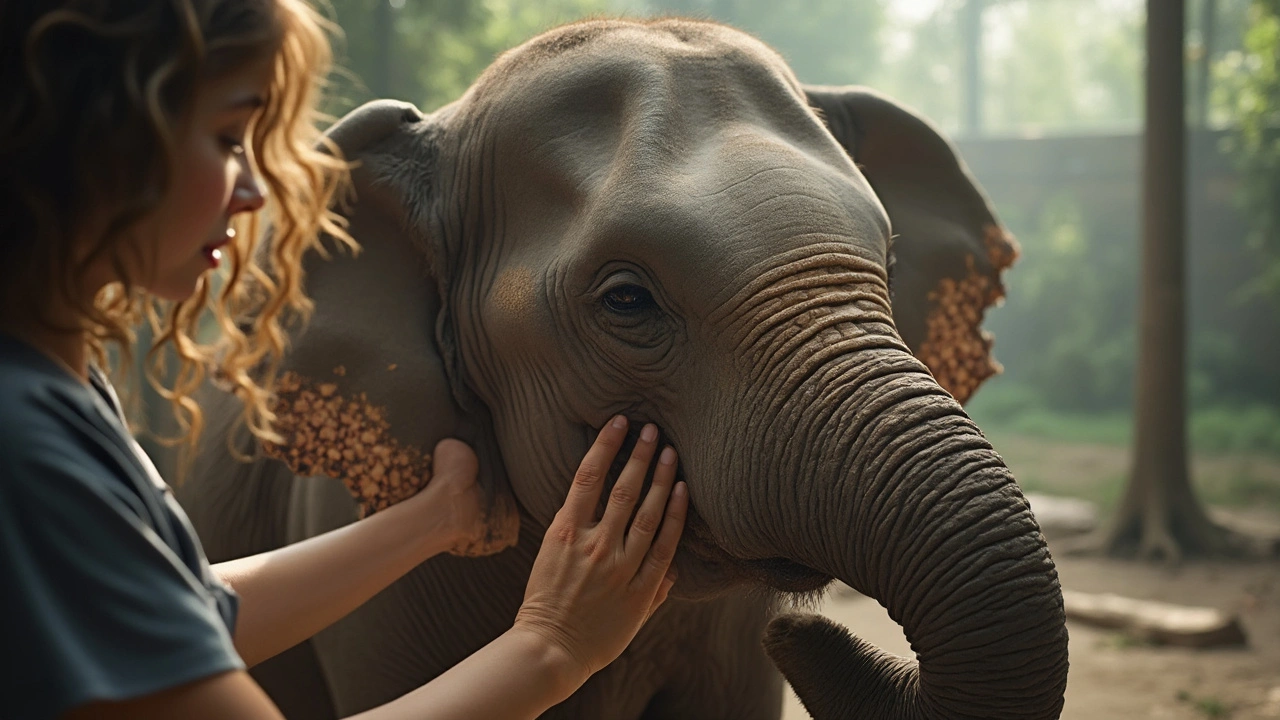Elephant Massage: The Science and Stories Behind a Surprising Practice
 Jun, 24 2025
Jun, 24 2025
Ask anyone who's seen it in person—watching an elephant get a massage is a wild mix of calm, surprise, and straight-up awe. It might seem odd at first, but elephants, just like us, get stiff joints, muscle knots, and even stress. The main goal? To keep these giants comfy, healthy, and relaxed.
Keepers started the massage tradition ages ago in countries like Thailand and India. At first, it was about bonding and trust, and it also helped massive working elephants recover after long stretches of hauling logs or giving rides. Now, caretakers know that regular massage can help keep elephants more flexible as they age and can even help with strange moods or crankiness.
- Why Elephants Get Massages
- How Elephant Massage Works
- Health and Wellness Benefits
- Tips for Safe Elephant Massage
Why Elephants Get Massages
If you picture elephants as tough and all muscle, you're only half right. Sure, they look unstoppable, but these huge animals are just as prone to aches as any athlete. Taking care of such a giant means thinking beyond just food and water. That's exactly where elephant massage comes in. The whole idea is to boost their comfort, mobility, and long-term health—especially when they're working or living in tight spaces like zoos or camps.
What’s wild is that elephant massage isn’t only a modern invention. In Thailand, handlers (called mahouts) have used bodywork techniques for hundreds of years. They noticed elephants moved better, healed faster, and even acted calmer after a hands-on session. Traditional elephant camps passed down this knowledge way before it popped up on wildlife documentaries or Instagram.
One thing that stands out is how the massage works for both retired and working elephants. Massage helps loosen tight spots and smooth out sore muscles, especially in elephants that pull loads, give rides, or walk long distances. Older elephants gain the most—they get stiff joints just like older people do, and they tend to get cranky when they're uncomfortable or in pain.
Stress is real for these animals. Loud noises, changes in routine, or crowded tourist spots can get them agitated. Regular massage sessions help keep stress hormones lower and can even cut down on odd repetitive behaviors, like weaving or head bobbing. Some zoos and sanctuaries report less aggression and fewer health problems when they include massage in care routines. See the table below for a bit of perspective on how massage helps:
| Benefit | How Massage Helps | Who Benefits Most |
|---|---|---|
| Mobility | Improves flexibility of joints and muscles | Older elephants, working elephants |
| Recovery | Reduces muscle soreness after physical tasks | Working elephants, injured elephants |
| Behavior | Lowers stress, reduces aggression and restlessness | All elephants, especially in captivity |
| Bonding | Builds trust between elephant and handler | New or rescued elephants |
The main takeaway: elephant massage means healthier, happier animals and fewer problems for handlers down the line. And as any mahout will tell you, an elephant with less pain is much easier—and safer—to work with.
How Elephant Massage Works
Elephant massage is way less mysterious than it sounds. You're not likely to see a spa with candles and essential oils. Instead, caretakers use a mix of traditional hands-on techniques and chunky massage tools designed for the tough hides of elephants. No delicate moves here—these animals have skin up to 2.5 centimeters thick in areas, so it takes some muscle to make a difference.
Usually, the massage session starts with simple touches around the trunk and ears, since those are sensitive areas. From there, keepers might use their fists, feet, or even wooden sticks to apply gentle but steady pressure along the elephant’s back, legs, and shoulders. Some elephant camps use water jets to loosen up tense muscles before the hands-on work begins.
One main goal is to boost blood flow, especially in older elephants who might not move as much. A well-known elephant vet, Dr. Preeda Prasopkaew, sums it up pretty well:
“Elephants can benefit from massage just like humans. It’s not only physical—regular sessions build trust and keep animals more relaxed in captivity.”
- Sessions typically last between 20-40 minutes.
- Most routines are done several times a week.
- Massage focuses on large muscles, joints, and sometimes the feet—which are a problem area for zoo/captive elephants.
- Pressure is firm, but never painful. Watchers keep an eye out for signs of discomfort.
| Fact | Details |
|---|---|
| Average session length | 30 minutes |
| Number of muscles in trunk | Over 40,000 |
| Skin thickness | Up to 2.5 cm |
| Common tools | Hands, feet, water jets, wooden sticks |
One more thing: the best results come from regular sessions and keeping things positive. If an elephant isn’t in the mood, a good handler never forces it. At the heart of all this, elephant massage is all about trust and understanding—a real bond between animal and human.

Health and Wellness Benefits
Let’s clear up a common myth: elephant massage isn’t just a novelty for tourists or a way to bond with these big animals. When done right, it brings actual health benefits that experts and elephant vets don’t ignore. Here’s the real scoop.
First, the most obvious win is muscle relief. A typical elephant weighs about 5,000 kilograms (yep, literally as much as a truck), and just standing all day can tire them out. Massage helps loosen muscle knots and gives stiff joints a break, especially for older elephants or those in captivity who can’t roam as far. Handlers report that stiff-legged elephants walk with a smoother step after a good session.
Also, massage helps elephants relax, which is a bigger deal than you might expect. Elephants in zoos or camps sometimes deal with stress or boredom, and caretakers often spot less swaying or head-bobbing after a massage. This is key since repetitive movements can be a sign of anxiety in elephants. And yes, they show less aggression too—a bonus for keepers and the herd.
There’s science backing this up, too. A 2017 study on captive elephants in Thailand showed that regular, gentle massage lowered their cortisol (the stress hormone) by as much as 25%. Happy elephant, happy life, right?
| Benefit | What It Means | Quick Fact |
|---|---|---|
| Better Circulation | Keeps blood moving so wounds heal faster | Older elephants with joint pain improved after weekly massages |
| Joint Health | Loosens up stiff knees and ankles | More flexible after 2-3 sessions |
| Lower Stress | Drops cortisol levels | Study: stress down 25% in massaged elephants |
| Improved Social Mood | Less fighting, more friendly | Handlers see calmer groups post-massage |
On top of these perks, regular elephant massage helps trainers spot early signs of illness—like an odd lump or sore the elephant can’t tell you about. It’s less about pampering and more like keeping tabs on a friend who can’t say where it hurts. That peace of mind for caretakers is huge, too.
Tips for Safe Elephant Massage
Giving an elephant a massage isn’t like hanging out with your neighbor’s dog—it takes know-how, respect, and serious attention to safety. These are huge animals with moods, quirks, and sometimes unpredictable reactions. If you’re a new handler or just curious, here’s what really matters.
First, you absolutely need training—never just walk up and try to rub an elephant like you would a pet. Most elephant keepers, called mahouts in Asia, go through years of practice. If you ever watch or help out, stick to the proven basics:
- Elephant massage should always be done with another experienced handler around, just in case the elephant shifts or reacts suddenly.
- Approach calmly and let the elephant see and smell you before getting close. Trust is key.
- Focus on big muscle groups in the shoulders, back, and behind the ears—these are the areas where tension builds up the most.
- Only use your hands or special thick wooden sticks (nothing sharp or metal) and avoid sensitive spots like the trunk and tail.
- Watch the elephant’s body language. If you see the trunk swaying hard, flapping ears, tail beating, or the foot stomping, stop right away. It could mean discomfort or annoyance.
Here’s a quick comparison of common body cues to watch for during a session:
| Body Language | What It Means |
|---|---|
| Relaxed ears, calm tail, soft eyes | All good—elephant is chill |
| Rapid tail flicks, tensed trunk, shifting feet | Feeling anxious or ticked off |
| Loud trumpeting, sudden movement | Back off, something’s wrong |
If you’re responsible for elephants in a zoo or sanctuary, set a regular schedule for massages—once or twice weekly is pretty common in places like Thailand. Elephants actually start looking forward to it when done right.
Remember, safety comes first. Never rush, always pay attention to both your own position and your elephant’s body, and check that equipment is safe before every session. It doesn’t take fancy gear or a magic touch—just smart habits and respect for the world’s largest land animal.
